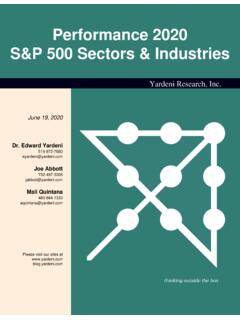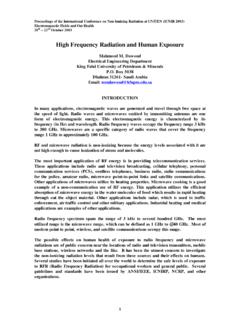Transcription of Satellite Communication - MIT OpenCourseWare
1 Satellite CommunicationCol John KeeseeSatellite Communications Architecture Identify Requirements Specify Architectures Determine Link Data Rates Design & Size each link Document your rationaleDefinition Uplinks Downlinks Crosslinks Relays TT & CUplinkDownlinkIntersatellitelinksRelay satelliteRelay satelliteRelay satelliteSensor satelliteSensor satelliteCrossover orIntersatellitelinksMission dataLaunchphaseTT&CTT&CSatelliteGround stationTT&CTracking, Telemetry and ControlThe communications architecture consists of satellites and ground stations interconnectedwith communications links. (Adapted from SMAD.)Architectures:Defined by Satellite -Ground Geometry Store & Forward Geostationary Molniya Geostationary/ Crosslink LEO/ CrosslinkAdapted from :Defined by Function System Function Tracking Telemetry & Command Data Collection Data Relay Satellite Design Onboard Processing Autonomous Satellite Control Network ManagementCommunications Architecture.
2 Selection Criteria Orbit RF Spectrum Data Rate Duty Factor Link Availability Link Access Time ThreatAdvantages of Digital Communication Less distortion and interference Easy to regenerate Low error rates Multiple streams can be easily multiplexed into a single stream Security Drift free, miniature, low power hardwareTracking Telemetry & Control Telemetry Voltages, currents, temperatures, accelerations, valve and relay states Commanding Low data rate Store, verify, execute or execute on time Programmable control Range or Range Rate Round trip delay yields range Doppler shift yields range rate Pseudo-random code Existing TT&C Systems AFSCN (SGLS) - AF Satellite Control Network (Space Ground Link System) NASA DSN - Deep Space Network Intelsat/ COMSAT TDRS - Tracking and Data Relay SatelliteData Collection MissioncycledutySecondSamplessamplePixel spixelBitsimagerDRbYVnXSwpushbroomDR_/)( )( Adapted from Definitions Chart 9 Variable DefinitionUnitsDR Data RateBits/secondSW Swath WidthMetersXAcross track pixel dimensionMetersVnGround track velocity Meters/secondY Along track pixeldimensionMetersbBits/pixelBitsReduc ing the Data Rate Increase the Duty Cycle Collect only above-threshold data Amplitude changes only Data compressionLink Design Process1.
3 Define Requirements for each link2. Design Each Link Select frequency Select modulation & coding Apply antenna size & beam width constraints Estimate atmospheric, rain attenuation Estimate received noise, interference power Calculate required antenna gain & transmitter power3. Size the Payload Payload antenna configuration, size & mass Estimate transmitter mass & power Estimate payload mass & powerLink EquationEbNo PLlGtLsLaGrkTsREnergy/bit to noise-density ratioVariable Definitions Chart 12 Variable Definition Units Units dBEbEnergy per bit Watt-seconds dBNoNoise spectral densityWatts/hertz dB P Transmitter powerWatts dBW LlLine loss dBGtTransmitterantenna gain db LsSpace loss DBVariable DefinitionsChart 12 continuedVariableDefinitionUnitsUnits (dB)LaTransmissionpath lossdBGrReceiver gaindBkBoltzmannconstantJ/KdBW/(Hz-K)TsS ystem noisetemperatureKRData rateBits/secondPower Flux DensityWf PLlGtLa4SS2 (EIRP)
4 La4SS2 EIRP - Effective Isotropic Radiated PowerVariable Definitionsfor Chart 16 VariableDefinitionUnitsUnits (dB)WfPower fluxdensityW/m2 SPath lengthMEIRPE ffectiveIsentropicRadiatedPowerWDBWR eceived PowerC Wf SDr2K4 PLlGtLaDr2K16S2Gr (SDr2K4)4SO2 S2Dr2KO2 Space LossLs (O4SS)2C EIRP*Ls*La*GrVariable DefinitionsChart 18 VariableDefinitionUnitsUnits (dB)CReceivedpowerWDrReceiverantennadiam etermdBKAntennaefficiencyOWavelengthmLsS pace lossLink Equation ConcludedEb energy/bit CRNo noise spectral densityN total received noise powerB receiver noise bandwidthNo=kTs N/BEbNo PuLluGtuLauGruLsk Ts RLink Equation in dBEbNo P Ll Gt Ls La Gr 228 . 6 10 logTs 10 logR EIR P Ls La Gr 228 .6 10 logTs 10 logRCNo EIRP Ls La GrTs EIRP Ls La GrTs 10 logBRIP EbNo GrTs 10 logR(Received isentropic power)Gain in dBGr S2Dr2KO2f cOG 20 logS 20 logD 20 logf 10 logK 20 logc (dB) 20 logD 20 logf 10 logK (dB)BeamwidthT [degrees]f [GHz]D [m]T 21f DG 27, 000T2LT 12(e/T)2 (dB)Antenna gainOffset beam lossSpace loss in dBLs O4SS 2 (ratio)Ls= - 20 logS- 20 logf (dB)System Noise Temperature- External to Antenna Galactic noise Clouds, rain in path Solar noise (in mainbeam or sidelobe) Earth (290K) Man-made noise Nearby objects Satellite structure(See SMAD Fig 13-7)System Noise Temperature- Internal to System Transmission lines and filtersFis a figure of merit for a receiverTr (1 L)
5 TL PoPi Low noise amplifierTr F 1 290 KTs Tant To1 LrLr ToF 1Lr Variable DefinitionsChart 21 VariableDefinitionUnitsTrReceiver noisetemperatureKLPower ratioTComponent temperature KPoOutput powerWPII nput powerWFNoise figureToReference temperature(usually 290 K)KModulation Modulation modifies an RF Carrier signal so that it contains input signal information Amplitude Frequency Phase PolarizationModulation Techniques BPSK - Binary Phase Shift Keying QPSK - Quadriphased Phase Shift Keying FSK - Frequency Shift Keying MFSK - Multiple FSK DPSK - Differential Shift KeyingBit Error Rate Primary Figure of Merit for Digital Link Performance Energy/bit (Eb) must exceed the noise spectral density (No) to achieve a required BERC oding Forward Error Correction sends additional data to help detect and correct errors. Reduces the Eb/No requirement Reduces required transmitter power Reduces antenna size Increases margin Increases data rate and bandwidthConvolutional Coding with Viterbi Decoding Extra bits sent with each block of data bits Receiver examines string of bits, generates possible code sequences, selects most likely Shannon limit Eb/No= dB Double coding necessary on deep space probesAttenuation Atmosphere absorbs some frequencies Divide zenith attenuation bysin(elevation angle)
6 Oxygen absorption at 60 GHz Scintillation disrupts below 200 MHzRain and Cloud Attenuation Crane model for world s climatic data Important above 10 GHz Worst for elevation angles < 20 degrees Rain reduces availabilityRain and Cloud AttenuationAdapted from MHzGBSU plinkACTSD ownlinkCommercial SATCOM ServicesCommercial SATCOM ServicesGovernment / Military SATCOM ServicesGovernment / Military SATCOM ServicesVHFUHFLSXKVVHFEHFAF / FLTSATCOMUFOM ilitaryUHFBandGovernmentS-Band (SGLS)USGovernmentX-Band1 GHz8 GHz18 GHz40 GHz75 GHzDSCSU plink500 MHzMilitary EHF (44/20)inmarsat, odyssey,iridium, globalstarodyssey,inmarsat,globalstarINT ELSAT,inmarsatINTELSATTELEDESIC,COMERCIA L,iridium,odyssey(gateway links)SPACEWAY, CYBERSTAR, ASTROLINKTELEDESIC iridium, odyssey (gateway links)Com Frequencies UsageALL CAPS = FixedSatelliteService (FSS)small case = MobileSatelliteService (MSS)/PersonalCommServices (PCS) Mhz400 , users aresecondary in UHF:subject to interferencefrom terrestrial usersHeavy orbital/terrestrialcongestion: much coordinationwith terrestrial users needed1 GHz1 GHz1 GHz1 GHz2 Mhz900 regular cellular(Land Mobile Radio)Freq at Risk: Int l &US CommercialencroachmentGPSL2 MhzL1 HEMISPHERELEGENDLOCATIONS OF CURRENT & PROPOSED GEOSTATIONARY SATELLITESWITH THRU DOWNLINKS= SKYSAT (PROPOSED)PROPERTY OF.
7 JOINT SPECTRUM CENTERREVISED 6-27-96= SAMSAT (PROPOSED)= EUROSKYWAY(PROPOSED)= SOUTH AFRICASAT(PROPOSED)= ARTEMIS (PROPOSED)= ASTROLINK (PROPOSED)= EDRSS (PROPOSED)= MORNINGSTAR (PROPOSED)= ORION (PROPOSED)= PANAMSAT (PROPOSED)= SARIT (PROPOSED)= INFOSAT (PROPOSED)=HISPASAT (PROPOSED)= GALAXY/SPACEWAY (PROPOSED)= GE STAR (PROPOSED)= MALTASAT(PROPOSED)= KASTAR (PROPOSED)= MILLENIUM (PROPOSED)= INTELSAT-KA (PROPOSED)= RADIOSAT (PROPOSED)= EASTSAT (PROPOSED)(PROPOSED)= CANSAT= DACOMSAT(PROPOSED)= CYBERSTAR (PROPOSED)= ECHOSTAR (PROPOSED)= DIAMONDSAT(PROPOSED)= USASAT (PROPOSED)= TOR(OPERATIONAL/PROPOSED)= USABSS(OPERATIONAL/PROPOSED)= TONGASAT(PROPOSED)= VISIONSTAR (PROPOSED)= VOICESPAN (PROPOSED)(PROPOSED)= VIDEOSAT= DFS (OPERATIONAL/PROPOSED)= BSB (PROPOSED)= EUTELSAT(OPERATIONAL/PROPOSED)= AFRISAT (PROPOSED)= LUX\KA (PROPOSED)(PROPOSED)= USCSID= ACTS (PROPOSED)=ITALSAT (PROPOSED)= N STAR (PROPOSED)= PAKSAT (PROPOSED)= MEGASAT (PROPOSED)= SUPERBIRD (PROPOSED)= DRTS (PROPOSED)= ASIASAT (PROPOSED)= CHINASAT (PROPOSED)= ARABSAT (PROPOSED)= KYPROS (PROPOSED)= TURKSAT (PROPOSED)=THIACOM (PROPOSED)= YAMAL (PROPOSED)Frequency Selection Drivers Spectrum availability and FCC allocation Relay/Ground Station frequency Antenna size Atmospheric/Rain attenuation Noise temperature Modulation and codingCommunication Payload Antennas Parabolic Helix Horn Phased Arrays Multiple beams Hopping beamsMilstar Satellite Layout Weight:10,000 lb Length:51 ft (across payload)116 ft (across solar arrays) Array Power:5,000 W Orbit Altitude:22,500 miles geosynchronous Launch Vehicle.
8 Titan IV/Centaur upper stageZ++XNSB #2 SHFTHRUSTERS+X WINGPAYLOAD(LDR)+X WING CROSSLINKANTENNASHFAGILERCVUHFEHFAGILEWS BXMTUHFECEHFECNSB #1 SPACECRAFT BUSREACTION WHEELASSEMBLIES (SCS)HORIZONSENSORSPROPELLANTTANKSFLEXIB LE SUBSTRATESOLAR ARRAY PANELSZ-X-THRUSTERS-X WING CROSSLINKANTENNA-X WING PAYLOADMDR NULLINGANTENNASCROSSLINKMDR DUCAANTENNAS(MDR*, CROSSLINK)UPLINK:5 AGILES, 2 NARROW SPOTS,1 WIDE SPOT, 1 EARTH COVERAGEDOWNLINK:SINGLE DOWNLINK TIME-SHARED BY:1 AGILE, 2 NARROW SPOTS,1 WIDE SPOT, 1 EARTH COVERAGEUPLINK:2 NULLING SPOTS6 DISTRIBUTED USER COVERAGE(DUCs)DOWNLINK:SINGLE DOWNLINK TIME-SHARED BY:2 SPOTS AND 6 DUCs(Image removed due to copyright considerations.)(Image removed due to copyright considerations.)Multiple Access Strategies FDMA - Frequency Division Multiple Access TDMA - Time Division Multiple Access CDMA - Code Division Multiple Access Phase Modulation plus pseudo-random noiseAntijam Techniques Spread Spectrum Narrow beamwidths On board processing Nulling antennasSpecial Topics Data security through encryption Spatial, time and Satellite diversity Frequency hopping InterleavingWhy Compress Data Need to send more data than bandwidth accommodates Digital image files in particular are very large Bandwidth is limited by the link equation and international regulation Concept inseparable from data encodingEarly Development -- Huffmancodes Assign different number of bits to each possible symbol to minimize total number of bits Example.
9 Encode letters of alphabet 26 symbols, each with equal chance of occurring => 5bits/symbol(25= 32 = lowest power of 2 above 26) If R occurs 50% of time, use fewer bits to encode Algorithms Lossless compression Ensures data recovered is exactly same as original data Used for executable code, numeric data -- cannot tolerate mistakes Lossy compression Does not promise that data received is the same as data sent Removes information that cannot later be restored Used for still images, video, audio - Data contains more info than human can perceive Data may already contain errors/imperfections Better compression ratios than Lossless (order of magnitude)When does Compression Pay Off? Compression/decompression algorithms involve time-consuming computations Compression beneficial when x / Bc+ x / (r Bn) < x / BnWhere Bc= data bandwidth through compress/decompressprocessBn= network bandwidth for uncompressed datar = average compression ratiox / Bn= time to send x bytes of uncompressed datax / Bc+ x / (rBn) = time to compress and send Simplified:Bc> + r / (r - 1) * BnLossless Compression Algorithms Run Length Encoding Differential Pulse Code Modulation -DPCM Dictionary-Based MethodsRun Length Encoding Replace consecutive occurrences of symbol with 1 copy plus count of how many times symbol occurs.
10 AAABBCDDDD => 3A2B1C4D Can be used to compress digital imagery Compare adjacent pixel values and encode only changes Scanned text can achieve 8-to-1 compression due to large white space Key compression algorithm used to transmit faxes Large homogeneous regions -- effective Small degree of local variation increases image byte size 2 bytes represent 1 symbol when not repeatedDifferential Pulse Code Modulation - DPCM Represent differences between data Output reference symbol For each symbol in data, output difference between it and reference symbol: AAABBCDDDD -> A0001123333 When differences are small, encode with fewer bits (2 bits vs 8 bits) Takes advantage of fact that adjacent pixels are similar Delta encodingencodes symbol as difference from previous one: AAABBCDDDD -> A001011000. Works well when adjacent pixels are similar Can combine delta encoding and RLED ictionary-Based Methods Lempel-Ziv (LZ) most well known, used by Unix compresscommand Build dictionary of expected data strings Replace strings with index to dictionary Example: "compression" (77-bi)














